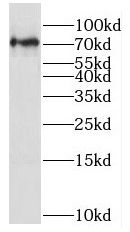Products
NR1D2 antibody
| Synonyms: | Nuclear receptor subfamily 1 group D member 2|Orphan nuclear hormone receptor BD73|Rev-erb alpha-related receptor (RVR)|Rev-erb-beta|V-erbA-related protein 1-related (EAR-1R)|NR1D2 antibody | ||
| Catalogue No.: | FNab05833 | Reactivity: | Human, Mouse, Rat |
| Host: | Rabbit | Tested Application: | ELISA, WB |
| Clonality: | polyclonal | Isotype: | IgG |
| Size | Price |
|---|---|
| 100µg | Inquiry |
- SPECIFICATIONS
- FIGURES
- CONDITIONS
- FAQS
- Product Name
- NR1D2 antibody
- Catalogue No.
- FNab05833
- Size
- 100μg
- Form
- liquid
- Purification
- Immunogen affinity purified
- Purity
- ≥95% as determined by SDS-PAGE
- Clonality
- polyclonal
- Isotype
- IgG
- Storage
- PBS with 0.02% sodium azide and 50% glycerol pH 7.3, -20℃ for 12 months(Avoid repeated freeze / thaw cycles.)
- Immunogen
- nuclear receptor subfamily 1, group D, member 2
- Alternative Names
- Nuclear receptor subfamily 1 group D member 2|Orphan nuclear hormone receptor BD73|Rev-erb alpha-related receptor (RVR)|Rev-erb-beta|V-erbA-related protein 1-related (EAR-1R)|NR1D2 antibody
- UniProt ID
- Q14995
- Observed MW
- 70 kDa
- Tested Applications
- ELISA, WB
- Recommended dilution
- WB: 1:500-1:2000
 HeLa cells were subjected to SDS PAGE followed by western blot with FNab05833( NR1D2 Antibody) at dilution of 1:300
HeLa cells were subjected to SDS PAGE followed by western blot with FNab05833( NR1D2 Antibody) at dilution of 1:300
- Background
- Transcriptional repressor which coordinates circadian rhythm and metabolic pathways in a heme-dependent manner. Integral component of the complex transcription machinery that governs circadian rhythmicity and forms a critical negative limb of the circadian clock by directly repressing the expression of core clock components ARNTL/BMAL1 and CLOCK. Also regulates genes involved in metabolic functions, including lipid metabolism and the inflammatory response. Acts as a receptor for heme which stimulates its interaction with the NCOR1/HDAC3 corepressor complex, enhancing transcriptional repression. Recognizes two classes of DNA response elements within the promoter of its target genes and can bind to DNA as either monomers or homodimers, depending on the nature of the response element. Binds as a monomer to a response element composed of the consensus half-site motif 5'-[A/G]GGTCA-3' preceded by an A/T-rich 5' sequence(RevRE), or as a homodimer to a direct repeat of the core motif spaced by two nuclegotides(RevDR-2). Acts as a potent competitive repressor of ROR alpha(RORA) function and also negatively regulates the expression of NR1D1. Regulates lipid and energy homeostasis in the skeletal muscle via repression of genes involved in lipid metabolism and myogenesis including: CD36, FABP3, FABP4, UCP3, SCD1 and MSTN. Regulates hepatic lipid metabolism via the repression of APOC3. Represses gene expression at a distance in macrophages by inhibiting the transcription of enhancer-derived RNAs(eRNAs). In addition to its activity as a repressor, can also act as a transcriptional activator. Acts as a transcriptional activator of the sterol regulatory element-binding protein 1(SREBF1) and the inflammatory mediator interleukin-6(IL6) in the skeletal muscle.
How many times can antibodies be recycled?
First, usually it's not suggested to recycle antibodies. After use, buffer system of antibodies has changed. The storage condition of recycled antibodies for different customers also varies. Thus, the performance efficiency of recycled antibodies can’t be guaranteed. Besides, FineTest ever conducted the antibody recycling assay. Assay results show recycling times of different antibodies also varies. Usually, higher antibody titer allows more repeated use. Customers can determine based on experimental requirements.
Notes: After incubation, we recycle rest antibodies to centrifuge tube and store at 4℃. High titer antibodies can be stored for a minimum of one week. Reuse about three times.
What are components of FineTest antibody buffer?
Components of FineTest antibody buffer are usually PBS with proclin300 or sodium azide, BSA, 50% glycerol. Common preservative is proclin300 or sodium azide, which is widely applied in the lab and industry.
How about the storage temperature and duration of FineTest antibodies?
Most antibodies are stored at -20℃. Directly-labeled flow cytometry antibodies should be stored at 2 - 8℃. The shelf life is one year. If after sales issues for purchased antibodies appear, return or replacement is available. Usually, antibodies can be still used after the one-year warranty. We can offer technical support services.
Is dilution required for FineTest antibodies? What’s the dilute solution?
Directly-labeled flow cytometry antibodies are ready-to-use without dilution. Other antibodies are usually concentrated. Follow the dilution ratio suggested in the manual. Dilute solution for different experiments also varies. Common antibody dilution buffers are acceptable(e.g. PBST, TBST, antibody blocking buffer).
How to retrieve antibodies for immunohistochemistry?
Common retrieval buffers: Tris-EDTA Buffer(pH 9.0); Citrate Buffer(pH 6.0)
Heat induced antibody retrieval:
Method 1: Water-bath heating: Put the beaker with retrieval buffer and slide in the boiling water bath. Keep the boiling state for 15min. Naturally cool to room temperature;
Method 2: Microwave retrieval: Put the beaker with retrieval buffer and slide in the microwave oven. Heat at high power for 5min, Switch OFF for 3min, Heat at medium power for 5min. Naturally cool to room temperature.
How to choose secondary antibodies?
(1) Secondary antibodies react with primary antibodies. Thus, secondary antibodies should be against host species of primary antibodies. E.g. If the primary antibody is derived from rabbit, the relevant secondary antibody should be against rabbit. E.g. goat anti rabbit or donkey anti rabbit.
(2) Choose secondary antibody conjugates according to the experimental type, e.g. ELISA, WB, IHC etc. Common enzyme conjugated secondary antibodies are labelled by HRP, AP etc. Fluorescin or dye labelled secondary antibodies are applied in immunofluorescence and flow cytometry(e.g. FITC, Cy3).
